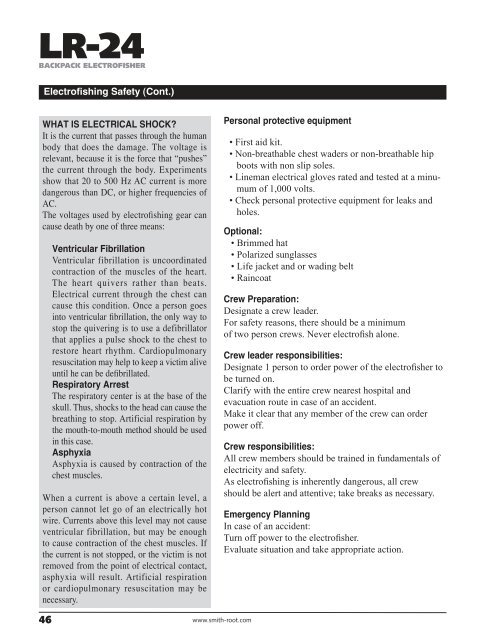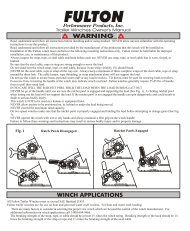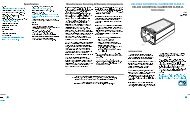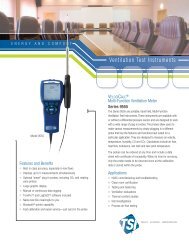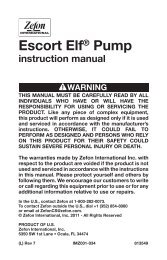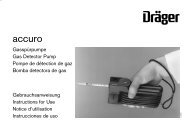LR-24 Electrofisher - Field Environmental Instruments
LR-24 Electrofisher - Field Environmental Instruments
LR-24 Electrofisher - Field Environmental Instruments
Create successful ePaper yourself
Turn your PDF publications into a flip-book with our unique Google optimized e-Paper software.
<strong>LR</strong>-<strong>24</strong><br />
BACKPACK ELECTROFISHER<br />
Electrofishing Safety (Cont.)<br />
WHAT IS ELECTRICAL SHOCK?<br />
It is the current that passes through the human<br />
body that does the damage. The voltage is<br />
relevant, because it is the force that “pushes”<br />
the current through the body. Experiments<br />
show that 20 to 500 Hz AC current is more<br />
dangerous than DC, or higher frequencies of<br />
AC.<br />
The voltages used by electrofishing gear can<br />
cause death by one of three means:<br />
Ventricular Fibrillation<br />
Ventricular fibrillation is uncoordinated<br />
contraction of the muscles of the heart.<br />
The heart quivers rather than beats.<br />
Electrical current through the chest can<br />
cause this condition. Once a person goes<br />
into ventricular fibrillation, the only way to<br />
stop the quivering is to use a defibrillator<br />
that applies a pulse shock to the chest to<br />
restore heart rhythm. Cardiopulmonary<br />
resuscitation may help to keep a victim alive<br />
until he can be defibrillated.<br />
Respiratory Arrest<br />
The respiratory center is at the base of the<br />
skull. Thus, shocks to the head can cause the<br />
breathing to stop. Artificial respiration by<br />
the mouth-to-mouth method should be used<br />
in this case.<br />
Asphyxia<br />
Asphyxia is caused by contraction of the<br />
chest muscles.<br />
When a current is above a certain level, a<br />
person cannot let go of an electrically hot<br />
wire. Currents above this level may not cause<br />
ventricular fibrillation, but may be enough<br />
to cause contraction of the chest muscles. If<br />
the current is not stopped, or the victim is not<br />
removed from the point of electrical contact,<br />
asphyxia will result. Artificial respiration<br />
or cardiopulmonary resuscitation may be<br />
necessary.<br />
Personal protective equipment<br />
• First aid kit.<br />
• Non-breathable chest waders or non-breathable hip<br />
boots with non slip soles.<br />
• Lineman electrical gloves rated and tested at a minumum<br />
of 1,000 volts.<br />
• Check personal protective equipment for leaks and<br />
holes.<br />
Optional:<br />
• Brimmed hat<br />
• Polarized sunglasses<br />
• Life jacket and or wading belt<br />
• Raincoat<br />
Crew Preparation:<br />
Designate a crew leader.<br />
For safety reasons, there should be a minimum<br />
of two person crews. Never electrofish alone.<br />
Crew leader responsibilities:<br />
Designate 1 person to order power of the electrofisher to<br />
be turned on.<br />
Clarify with the entire crew nearest hospital and<br />
evacuation route in case of an accident.<br />
Make it clear that any member of the crew can order<br />
power off.<br />
Crew responsibilities:<br />
All crew members should be trained in fundamentals of<br />
electricity and safety.<br />
As electrofishing is inherently dangerous, all crew<br />
should be alert and attentive; take breaks as necessary.<br />
Emergency Planning<br />
In case of an accident:<br />
Turn off power to the electrofisher.<br />
Evaluate situation and take appropriate action.<br />
46 www.smith-root.com


